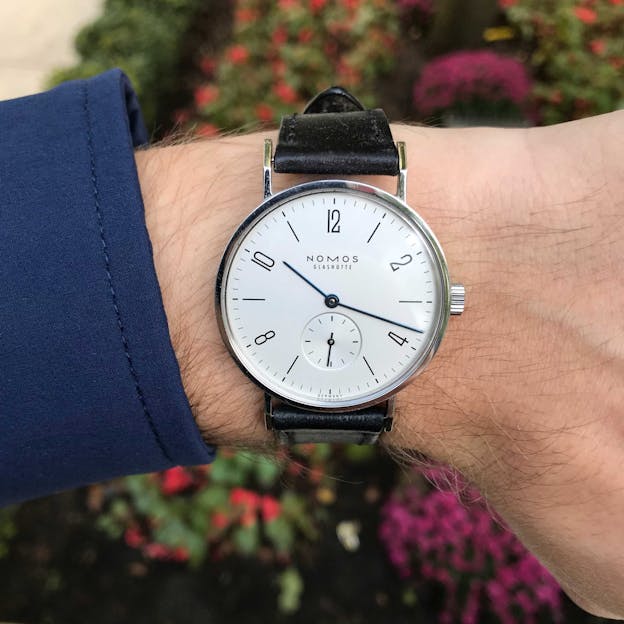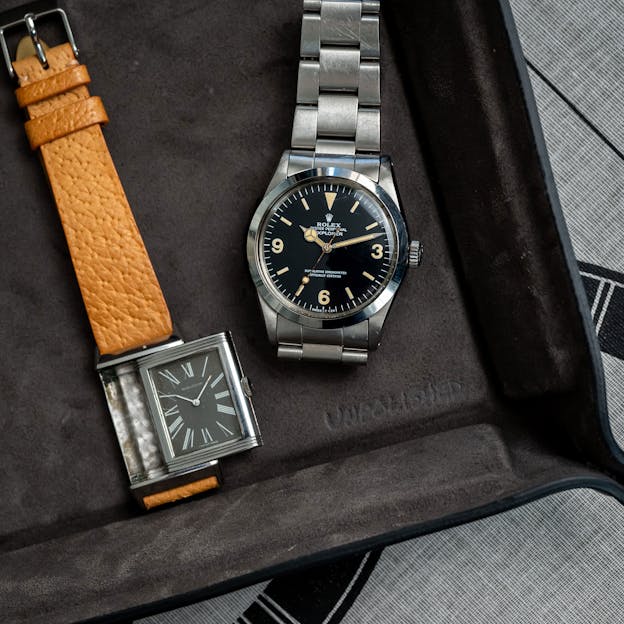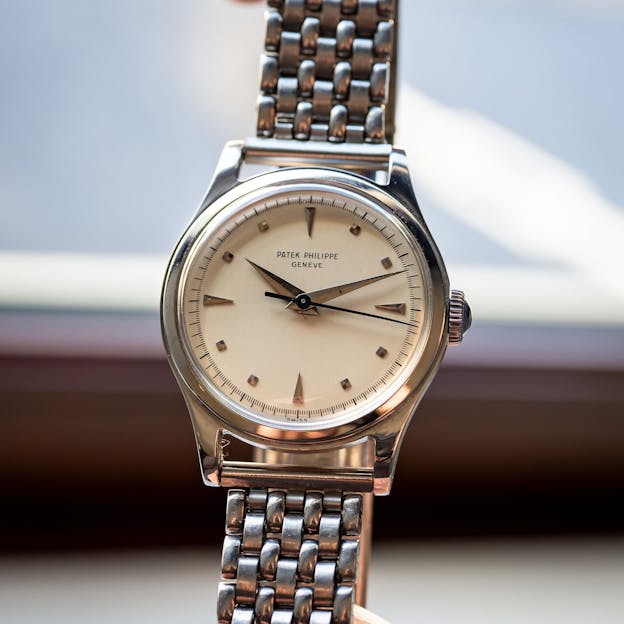Profiles in Time: Tony Traina’s Journey Through The Watch World
From Rescapement to Unpolished, Tony Traina’s rise as an independent voice in watch journalism combines sharp wit, deep analysis, and a passion for storytelling that resonates beyond the industry noise.
As a writer, you have to love to read, and specifically as a watch writer, you need to love to read about watches. When you get deep into this game, one thing becomes apparent quite quickly, and that is most watch writing is pretty, how should I phrase it, “par for the course,” and tends to come across as just another branded sales pitch generated from halfhearted press releases.
As much of modern watch media focuses on celebrity watch sightings, new releases, technical specifications, market values, and the relentless chase for what’s next, it’s imperative not to overlook the people behind the coverage—those whose perspectives and insights deepen our connection to these beautiful and very necessary timepieces.

Over the years, I’ve developed a deep appreciation for certain writers—voices of authority who stand out amid the noise. Some I’ve followed for what feels like decades, while others are newer to the scene. One such writer I greatly admire is Tony Traina, a rising star whose prominence has grown since his first newsletter (Rescapement) appeared during the pandemic. The former Hodinkee editor and now an independent journalist, Tony’s sharp wit, deep analysis, and distinctive perspective on watches set him apart in a very crowded field. There are not many people who can write a comprehensive collectors guide to the Patek Philippe ref 3970 as well as quote David Grohl when discussing a philosophical view of collecting vintage timepieces.
It’s a curious world, the watch industry. Mainly because, outside of actual watchmaking, no one goes to school to study watches the way they might study art, music, or fashion. It’s a genre—a subset of culture—you come to on your own. Sure, there are exceptions to this rule. If your last name is Arnault, Stern, Hayek, Meylan, or even Biver, you’re born into it. But the rest of us plebs latch onto this community and, in some cases, find our voices within it.
That’s precisely what makes Tony Traina’s story so compelling. Unlike industry veterans who have spent decades building their presence, he seemingly emerged out of nowhere during the pandemic—carving out a space for himself in record time. It’s a stark contrast to figures like our very own Jack Forster, who has been embedded in the watch world for ages, moderating forums since the dawn of the internet. Tony’s rapid rise in an industry that often feels insular and slow-moving is what made me want to sit down with him.
Recently, I had the privilege of doing just that—interviewing Tony to learn more about his journey into the watch world, what drives him, and what he’s up to today.
The Beginning
Greg Gentile: I suppose there is no better place to start other than the beginning. So, how did this all start for you? How did your journey into watches begin?
Tony Traina: I had first inherited a few of my grandfather’s watches and got into them a little bit when I had graduated college. But when I really got into them on a consistent basis was after law school. I was getting married and the journey really begins with the classic story of looking for something nice to buy for my wedding.

So, I got into it as an enthusiast at first. I ended up buying a Nomos Tangente, which got me hooked. From there, I discovered vintage watches on eBay, picking up affordable pieces like Midos and Movados. That snowballed into exploring vintage Tudor, Cartier, and Rolex.
I started writing about them a little bit before the pandemic, but when the pandemic came I focused on the weekly newsletter format as a fun way to do something without feeling overburdened by it all.
Digging into vintage references, I kind of just published what I discovered about them. And it was a weekly newsletter for a couple of years and then at some point I started getting requests to write from publications like A Collected Man and Hodinkee and then it took off from there.
GG: Recently I was chatting with Tim Mosso about watch writing. Tim, who we all know from his video’s surprised me by stating how he considers himself a man of letters first. In that conversation asked me a question that I would love to get your personal take on. How do you view yourself—a writer who loves watches, or a watch enthusiast who writes?
TT: I was interested in the process of writing before watches. I never thought I would make a career out of it. But writing came first for me. I worked on my student newspaper in college as the beat writer for the basketball team and later for the Northwestern Law Review. I had always really enjoyed writing.
Watches became an interest later on, but writing about [watches] allowed me to combine two passions—creative writing and horology. Being a lawyer you’re not doing much creatively, so writing about watches became a great creative outlet for me.
GG: Were there any “Oh- shit, I’ve made it” moments in your watch writing career? You know, that moment of reflection where you are looking around and thinking how did I get here?
TT: The first time someone pays you to write about watches is kind of funny right? I think it was A Collected Man [who gave me my first commissioned article]. It made it feel more than a hobby.
Another highlight was my first press trip to Rolex in Geneva—seeing the manufacturing process up close was unforgettable. Being able to do that and see inside [of the manufacture] is something that not a lot of people have the privilege of being able to see.
I distinctly remember taking the elevators down to see part of their assembly and QC facility. It’s below the ground floor, something you’d never guess was sitting there right on the outskirts of downtown Geneva. It felt like one of the biology labs I’d worked at in college. Fluorescent lights, white walls and floors, lab coats and million-dollar equipment everywhere you look.
This was when Rolex released its first titanium watch, that humongous Deep Sea Challenge. I remember sitting down and speaking with the head of Rolex R&D. I can’t remember a thing he said, but I’ll never forget how clearly proud he was of what he and his team had built. I think of that all the time, a reminder that there are people behind these watches, even at the biggest companies in the world.

Looking Forward
Tony has not been silent regarding his take on watch media, where is is and where he thinks it is going. When he left Hodinkee this past year — it appeared multiple times in his revamped newsletter.
GG: How do you view the state of watch journalism today? Where do you think it is going?
TT: It’s at an interesting crossroads. Over the past 15 years, we moved from enthusiast driven forums to professionalized blogs. Hodinkee obviously being the first and foremost among them, which proved that [watch media] could be a successful business. They created a space for a lot of the independent creators that are doing things now.
[Today] We’re in a creator-driven era—TikTokers and influencers are getting attention, but monetizing that is still a challenge. We’ll see [where it goes]. I think I would like to see more creativity and innovation in the ways in which you can monetize [content] and engage audiences.
I look to the car world for example. Those guys have big followings and have created marketplaces, events, and all kinds of cool things beyond just getting a brand deal or an advertising deal.
Subscriptions are kind of a piece of that and I’m encouraged by the fact people will pay [for content] on some level. [And I think] if you hold yourself out there as independent and retain those ideals people will continue to support and do want to support independents.
[This is not the first time Traina has expressed this sentiment. In his newsletter he recently reflected on the state of watch media saying — “I’m not crazy about the shift towards creators and influencers. It often lacks substance and can feel very transactional. Turns out, brands can buy a slot in all those “12 Best Bronze Watches” guides. Even I struggle to tell what’s genuine vs. sponsored – and I do this for a living.”]
GG: What’s next for Unpolished?
TT: I think the community aspect will be something I build out next… whether it’s through Slack, or a WhatsApp, I am not quite sure. I want to build that out in a way that adds additional value that will bring in people that might never pay for content but want to be a part of a community. Part of that will also be in person events. Some small relatively intimate things.
The State Of Tony’s Collection

GG: Do you have a “no-sell” watch in your collection?
TT: The Nomos I wore for my wedding is special, but I’d also say my Rolex ref. 1016 Explorer. It represents a lot of my collecting journey, especially my love for Explorers and Rangers. It’s a watch I’d only part with to upgrade to a grail piece in that lineage.
GG: What’s a type of watch you’d like to add to your collection?
TT: A high-end, manually wound dress watch. I’m eyeing pieces like the Chopard L.U.C. caliber 196 or a 90s-era Calatrava. There’s something romantic about the ritual of winding a finely made dress watch.

GG: What do you do outside of watches? What else should the world know about Tony Traina?
TT: It’s funny, I have been trying to figure out another hobby since watches were my hobby for so long but now they are my profession. But I do play a lot of golf. I grew up playing and especially during COVID really got back into it.
The Watch Writer’s Writer
I believe that what sets Tony apart in the world of watch journalism is that he came into this world because he loved watches first.
When that’s your starting point—before the prices, the pomp, and the luxury industry’s glitz—it brings an innocence, a purity, to how you talk about watches. You’re not jaded, just passionate. And that’s pretty damn cool, if you ask me.
I think for most of us—and I’ll make a broad assumption here, appealing to what I deem the purists in this field—Tony represents more than just a voice of authority. He’s not just authentic, not just independent, but most importantly, genuine. There are many intelligent and talented writers out there who simply miss the mark when talking about random eBay finds or a deep dives into 70’s Cartier watches. Tony writes from a place that allows us all to connect; his tone is never pejorative, but always informative, which is a fine line to walk when writing about watches.
Tony’s journey has been remarkable: from an enthusiast blogging at home about his passion to writing for the biggest name in watch media, and now forging his own path, pioneering independent journalism in the watch world. His success at every stage isn’t accidental. He’s seen the inner workings of the media behemoth but continues to resonate with readers through his commitment to independence. He stands on merit, delivering insight and candor about collecting—and, above all, loving—these fascinating little machines we obsess over for a living.

